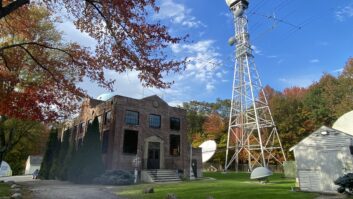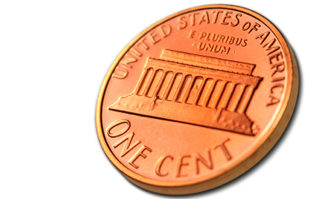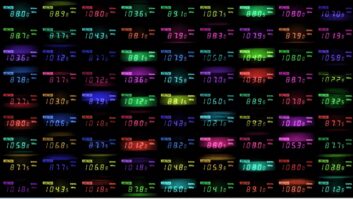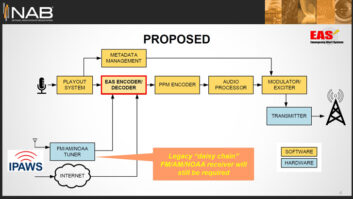If we were to journey back in time and visit the engineering shop of a radio station in the 1960s or ’70s, it would look very similar to the repair facilities of a hi-fi or radio-TV repair shop of the day. There would be a carpeted workbench and a shelf above filled with test equipment — VTVMs, RF signal generators, an audio oscillator, distortion meter, signal tracer and an oscilloscope. The quantity and quality would vary as a function of the engineering budget.

Front view.
Also, we would find a stock of electronic components, resistors, capacitors, diodes, vacuum tubes, transistors and a bit later, integrated circuits. Bins with pinch rollers, belts and heads would be on hand to keep the station’s cart machines and tape decks rolling along.
Unique to the radio station’s shop, however, there would also be a quality communications receiver connected to an outside antenna. Most likely, it was used by the engineer to listen to some of the great top 40 stations of the day while working alone on long overnight maintenance shifts, or possibly to hear shortwave broadcasts from around the globe on cold winter nights.
But the real purpose of having a communications receiver at the station was not to provide entertainment for the chief engineer. It was all about compliance with FCC rules.
This time around in our Plugging into the Past feature, we’ll examine the Hallicrafters SX-42 communications receiver, and talk about why these radios were an important calibration tool and also a part of the annual proof-of-performance measurements.
SX-42
The SX-42 was the flagship of the post-war Hallicrafters product line, replacing the 1940 SX-28 Super Skyrider. Released in 1947, it had the most extended band coverage of any receiver in the early ’50s. Originally, that meant five bands topping out at 55 MHz. But when the FCC announced that the FM broadcast band would be moved from its prewar 42–50 MHz home to its current 88–108 MHz location, Hallicrafters quickly added a sixth band, bringing coverage up to 110 MHz.
This double-conversion receiver sold for $275, quite a chunk of change in those days. But then, it had a lot of features most receivers didn’t have. Its 15-tube chassis featured a crystal filter, BFO, six-position selectivity switch, noise limiter and continuous FM coverage from 27–110 MHz. To make this complicated receiver less intimidating for non-technical users, the various switch positions for AM/FM broadcast were clearly marked with red dots.

Bottom view.
Not only did the SX-42 have more features than pre-war sets, it looked entirely different. Plastics had evolved during the war years, creating a lot more options for cabinet designs than the black and brown bakelite that was the norm before the war. To capitalize on these new materials, Hallicrafters commissioned the noted industrial designer Raymond Loewy to create the cabinet design for the SX-42. Loewy is well remembered for his work on the Pennsylvania Railroad, Studebaker and NASA.
The traditional black crinkle front panel was replaced by one with a pleasing light grey finish and green lettering. The main tuning dial, bandspread dial and S-meter face were green plastic, which filled the DXers radio shack with a pleasing green glow. For the radio enthusiast of the late ’40s, it must have looked like something that arrived from out of the future.
Part of the annual proof for AM stations was measuring spurious radiation, including RF harmonics, to ensure they were low enough to prevent harmful interference. The procedures for doing this were not that well defined in the regulations, as no numerical measurements were spelled out. A communications receiver was normally used.
Steps needed to be taken to ensure that the front end of the receiver would not be overloaded, and that could entail adding an RF attenuator ahead of the antenna. Usually the studio was located well within the station’s coverage area, and measurements were taken from the shop using an external long wire antenna.
The receiver was slowly tuned up from the fundamental frequency, paying particular attention to the second and third harmonics. Good engineering practice dictated a sweep all the way up to the 10th harmonic, or the upper limits of the receiver’s frequency range. The details were noted in the proof, adding that no harmonics were audible. When problems did occur, it was usually with excessive second or third order harmonics, which often boiled down to misaligned or lightning-damaged harmonic traps in the transmitter.

For FM stations, a communications receiver with a BFO such as the SX-42 was essential for calibrating the modulation monitor by using Bessel’s Function. This was typically done before the proof. First, the receiver’s antenna was connected to the first limiter tube of the monitor by wrapping a few turns of wire around it. Then, it was tuned to the monitor’s IF frequency by peaking the S meter. Typically, this was 21.5 MHz to 22.7 MHz, depending on the station’s frequency. The receiver’s BFO was adjusted for around 300 Hz. The FM monitor was set to display total modulation on the meter.
Next, precise audio frequencies which corresponded to various percentages of modulation at different null points were fed to the FM transmitter. There was usually a chart in the monitor’s manual that listed these. For example, a frequency of 8,670 Hz corresponds to 100 percent modulation at the third null. The amplitude of the audio oscillator was increased while noting the nulls from the receiver. With the third null, the transmitter was modulating at 100 percent. Then, the calibration tweaks on the monitor for meter and flasher were adjusted. It was usually good practice to repeat the process for nulls yielding lower modulation levels to confirm the meter’s linearity, and the flasher’s accuracy. All this, of course, was logged in the station’s maintenance log.
In addition to assisting with proofs, the SX-42 was often used to assess the overall quality of a station’s AM and FM signals. With its 6V6 push-pull output stage and high-quality output transformer, this receiver was capable of impressive audio quality.
Many communications receivers of the day had single-ended audio output stages and mediocre wideband performance. This was not surprising, since the audio quality of short-wave broadcasts and amateur communications traveling half way around the globe was far worse than that of AM radio.
THE END OF THE LINE?
In the end, the inevitable march of time and newer technologies took its toll on those communications receivers in the engineering shop. By the 1970s, many of them were approaching the 30-year mark. While they were still working, they were probably not working well. A complete overhaul and alignment was needed, but it was usually much more cost-effective just to purchase one of the many high-end portable communications receivers, which could do double duty on the bench and in the field.
At the same time, RF spectrum analyzers such as the Tektronix 491 were being introduced. They were much better diagnostic tools for tracking down harmonic and intermod issues than a communications receiver. Early spectrum analyzers were expensive, but typically at least one station in a market had one. Usually it was the TV guys.
As to calibrating FM mod monitors, the newer solid-state devices were much more stable, and had internal calibrators. Their calibration was a bit more complicated than older devices, and they usually made a trip back to the factory to be tweaked every five years or so.
The SX-42 shown in this story has just such a history. It came from the engineering shop of a suburban Boston radio station. It had been forgotten in the attic until the mid-1980s. When new cable troughs were being routed above the ceilings, it was rediscovered. When plugged in, it fell into the “working, but not working well” category.
The first step was rounding up the usual suspects. Switch contacts and pots were given a good cleaning with DeOxit. Many of the original wax capacitors remained, and they, along with the aging electrolytics were replaced. All the tubes were tested, and several in the front end were renewed.
A service manual was located, then it was a matter of measuring and logging voltages at the tube sockets and replacing numerous out-of-tolerance resistors.
Restoration work on this SX-42 has been interrupted by a few long distance moves, as well as being locked away in storage for 15 years. It works reasonably well, but needs a thorough cleaning and careful alignment.
The SX-42 was a landmark receiver when it was introduced in 1947. Its sleek industrial design, high quality construction, extended band coverage and high-quality audio output are what made it a such a standout receiver, and why it is still sought out by collectors and radio amateurs.
Comment on this story or suggest future products to feature. Email[email protected]with “Plugging Into the Past” in the subject line.







